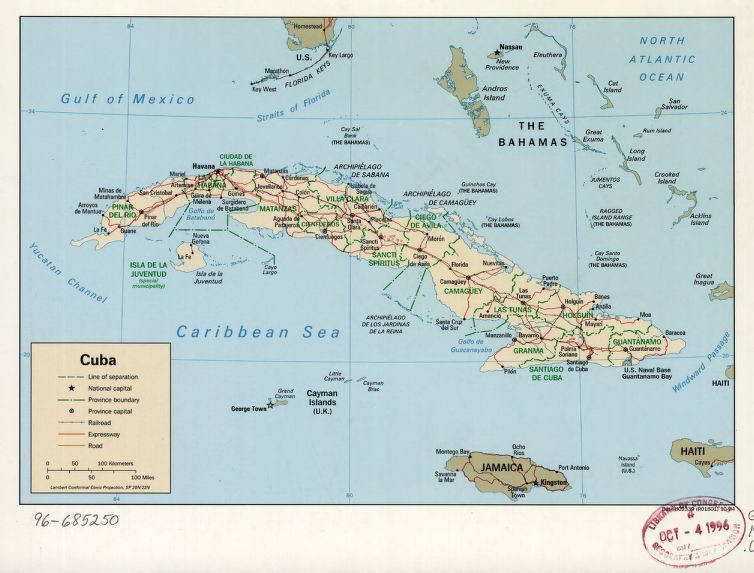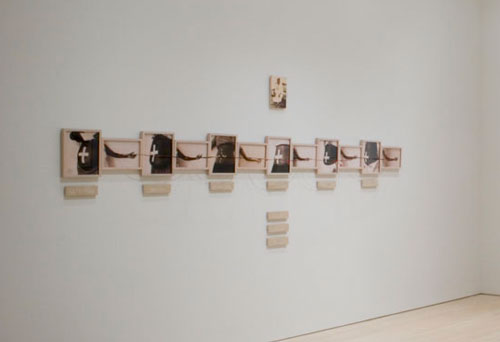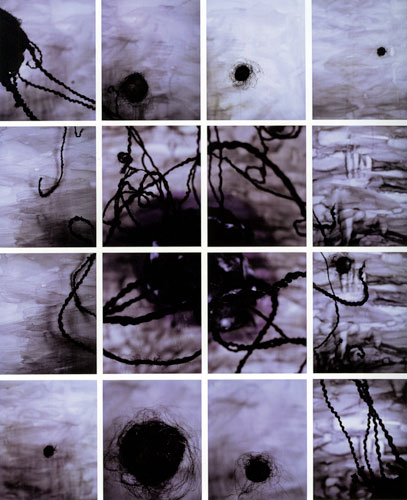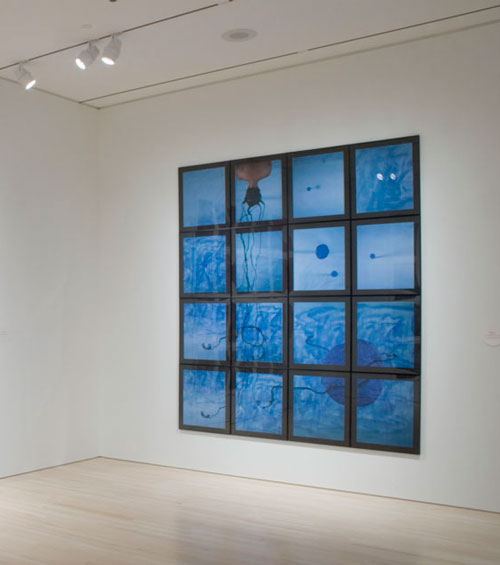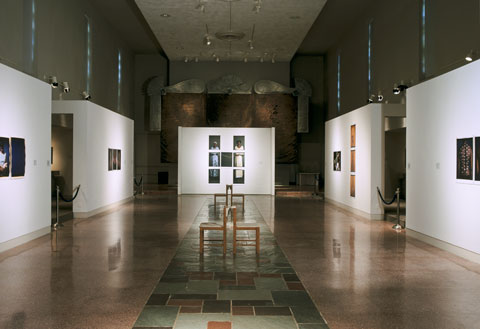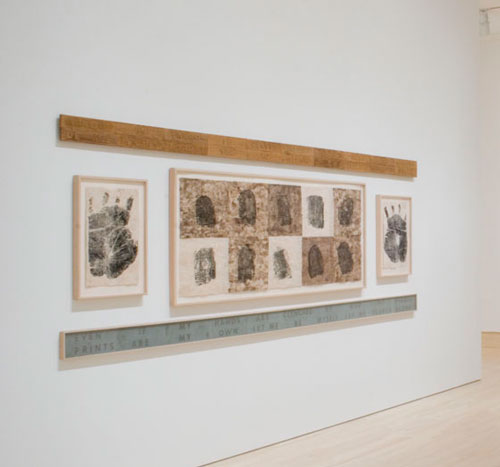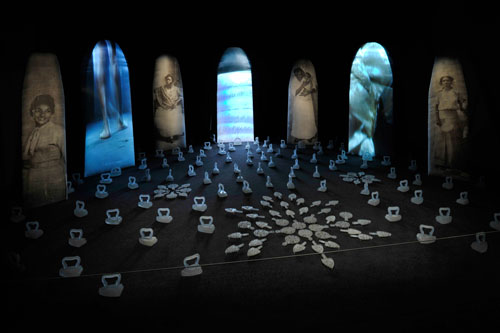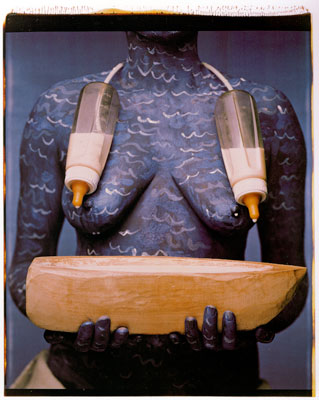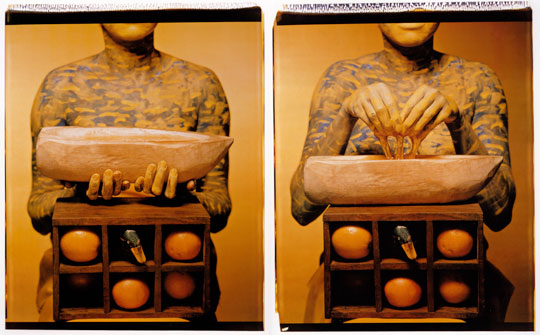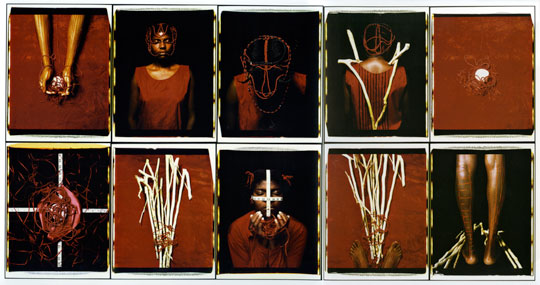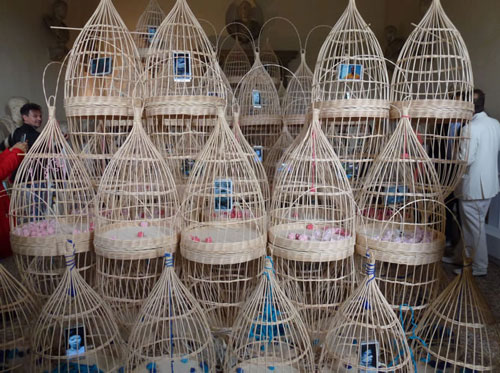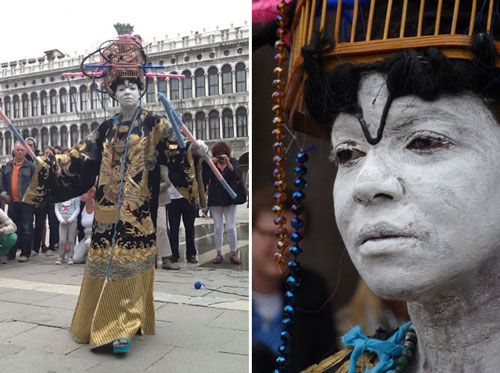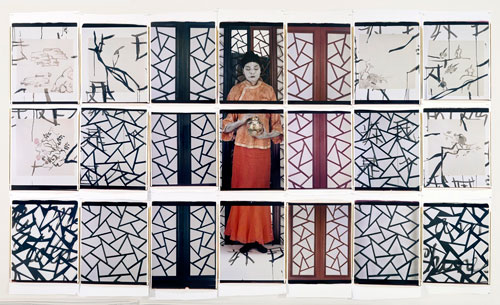Episode 7: Maria Magdalena Campos-Pons
Release date: Nov. 11, 2013
Multi-disciplinary artist Maria Magdalena Campos-Pons came to Saint Louis University in March 2013 to deliver The Kristen Peterson Distinguished Lecture in Art and Art History. Her talk, titled “Rituals and Spirituality in the Performative Photographic Work of Maria Magdalena Campos-Pons,” concerned her exploration of themes of separation, fragmentation, and memory through multiple artistic disciplines. Watch the talk here.
The day before her talk, Campos-Pons sat down with MOCRA Director Terrence Dempsey, S.J., and Dr. Olubukola Gbadegesin, Assistant Professor of Art History and African-American Studies at Saint Louis University, for a rich and varied discussion of Campos-Pons’ work as an outgrowth of her life experiences and passions, as well as her work’s place in the wider context of diaspora art.
Campos-Pons notes, “I am always in awe of the extent of mystery that is there present in our surroundings . . . I see myself not just as an artist but a healer, a messenger dispensing small amulets of good energies to my viewers and centered by respect for all that is animated.”
Be sure to listen to the Audio Extra, “Porcelain Doll.” Scroll down for a Listening Guide to the conversation.
The Conversation
Audio Extra: Porcelain Doll
MOCRA Voices on Stitcher MOCRA Voices on iTunes MOCRA Voices on Spotify
Related Exhibition
Rito, Espejo y Ojo / Ritual, Mirror and Eye
Related Episodes
Maria Magdalena Campos-Pons: The Kristen Peterson Lecture
Episode 23: Martha Schneider
Credits
Producer: David Brinker
Recording Engineer and Editor: Mike Schrand
Listening Guide: David Brinker, with helpful assistance from Cristóbal Torres, O.P.,
and Dr. Olubukola Gbadegesin
Background
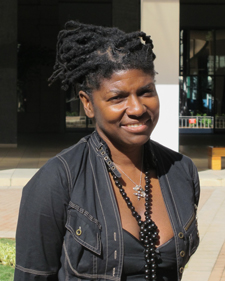
Maria Magdalena Campos-Pons was born in Matanzas, Cuba, and trained at the National School of Art and the Superior Institute of Art (ISA) in Havana. In the 1980s she studied at the Massachusetts College of Art in Boston. She has lived and worked in Boston since 1991 and has exhibited globally in venues such as the Johannesburg Biennial, the Dak’Art Biennial in Dakar, Senegal, the Guangzhou Triennial in China, and the Venice Biennale. In 2006 the Indianapolis Museum of Art presented a 20-year retrospective of Campos-Pons’ work. Her art is found in important public and private collections, including the Museum of Modern Art, The Whitney Museum of American Art, the Polaroid Collection, the Museum of Fine Arts (Boston), and The Victoria and Albert Museum, as well as the MOCRA collection. Campos-Pons received Boston’s Woman of Courage Award in 2011 and the Woman of Color Award in 2012. She taught at the School of the Museum of Fine Arts in Boston, and is presently Cornelius Vanderbilt Endowed Chair of Fine Arts at Vanderbilt University.
Campos-Pons works in a variety of media, including photography, painting, sculpture, and performance video. Recurring themes in her work include maintaining ties with the people and land from which she comes, the special character and role of women's discourse in society, and the nature of family communication. Many of her works are autobiographical-some are expressions of absence, loss and dislocation, but they also convey a deep appreciation for the resilience of her unique Afro-Cuban heritage. MOCRA first exhibited work by Campos-Pons in the 2004 exhibition “Rito, Espejo y Ojo / Ritual, Mirror and Eye.” Since then several of her works have entered MOCRA’s collection.
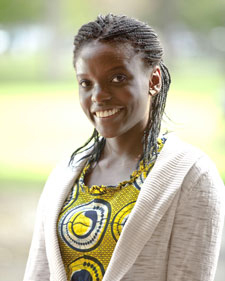
Dr. Olubukola Gbadegesin joined the Art History Program in Saint Louis University in Fall 2011 as a joint appointed faculty member with the African-American Studies and Art History Programs. Previously, she was a Post-doctoral fellow in the Art History program at Bowdoin College, a Pre-doctoral fellow at the Carter G. Woodson Institute at UVA. And she received her PhD in Art History from Emory University. Her research interests are primarily focused on photography, portraiture and print culture in Africa and the Diaspora. She teaches courses on historical and contemporary, visual and performing arts in Africa and the Diaspora. She has published in African Arts and contributed to various texts. Her upcoming publication in History of Photography (UK) is titled: “‘Photographer Unknown’: Neils Walwin Holm and the (Ir-)retrievable Lives of African Photographers.” She is currently working on first manuscript: “Picturing Modern Selves in Colonized Places: Photography as a Strategy of Power in Lagos, Nigeria.”
Listening Guide
Jump to the Listening Guide for Audio Extra: Porcelain Doll
| 02:25 | Fidel Castro (1926–2016) was the primary leader of a seven-year armed effort by Communist rebels to oust Cuban President Fulgencio Batista. Batista ultimately fled Cuba on January 1, 1959, and the Communist party came to power, setting in motion a series of reforms that had a major impact on the island nation and let to international repercussions that are still playing out in the present day. Read a general summary of the Cuban Revolution on Wikipedia. | |||||
| 07:40 |
Matanzas is the name for both a Cuban province and its capital city. Founded in 1693, Matanzas is renowned for its rich cultural heritage, including artists, poets, musicians, and Afro-Cuban folklore. It is called the City of Bridges and the “Venice of Cuba,” owing to the seventeen bridges that cross the three rivers that traverse the city, as well as “The Athens of Cuba” for its poets. The province of Matanzas saw intensive development of sugar plantations during the colonial era, resulting in the importation of a large number of African slaves to support the sugar industry.
|
|||||
| 08:50 |
The large-format Polaroid 20×24 camera was developed in 1976; five cameras in addition to prototypes were produced. Presently, two functioning cameras are in New York City, one in Cambridge, MA, one in Prague, and one in Paris. An additional camera is found in the Harvard Museum of Scientific Instruments. According to the 20 x 24 Studio website, The 20×24 camera is a traditional view camera, but has hybrid characteristics of a rail camera and field camera. It weighs 235 pounds and sits on a rectangular frame on wheels that supports a two-column studio stand. The bellows is driven by a telescoping nylon gear that allows bellows extension from 17" to 60". The front standard has 24" of rise and fall, 6" of side to side shift and the ability to swing 4" forward and back. The rear standard of the camera is static and has no independent rise and fall separate from the camera itself. The camera can descend to 24" and rise to a height of 72". Massachusetts College of Art and Design was founded in 1873 as the nation's first independent public college of art and design, and has the further distinction of being the first art school to grant a degree. Jeffrey Keough was the school’s director of exhibitions for over twenty-five years. |
|||||
| 10:05 |
|
|||||
| 10:50 | ||||||
| 13:10 | See discussion of Abridor de Caminos below, at 39:05. | |||||
| 14:10 | ||||||
| 14:40 |
“Rito, Espejo y Ojo / Ritual, Mirror and Eye” was a 2004 MOCRA exhibition featuring work by three contemporary Latin American photographers: Luis González-Palma, Maria Magdalena Campos-Pons, and Pablo Soria. Campos-Pons’ large-format Polaroid work was displayed in MOCRA's nave gallery. In 2007 the Indianapolis Museum of Art (IMA) presented a Campos-Pons retrospective titled “Everything Is Separated by Water.” The exhibition traveled to the Bass Museum of Art in Miami Beach later that year. Find the exhibition catalogue through WorldCat. In this video, Campos-Pons discusses the exhibition with IMA Curator of Contemporary Art Lisa Freiman: |
|||||
| 16:45 |
The term African diaspora refers to communities throughout the world that are descended from the historic movement of peoples from Africa. In particular, the term is applied to the descendants of the West and Central Africans who were enslaved and shipped to the Americas by way of the Atlantic slave trade. Explore articles on all sorts of topics related to the African diaspora on AfroCubaWeb. More recently, the Cuban Revolution and subsequent international response led to a new form of diaspora, in which many Cuban families were broken up as some members fled the island for the U.S. other destinations, then were unable to return or communicate with those left behind. Recent years have seen some improvements in U.S.-Cuba relations, but freedom of movement between the two countries is still limited. Santería is an Afro-Caribbean religion that developed as a result of the Cuban slave trade. Enslaved Africans brought from Benin and Nigeria mixed their Yoruba religious traditions with elements of the Roman Catholic faith of the plantation owners. For a long time Santería was a secret religion primarily practiced by the uneducated and poor in Cuba, but it has spread beyond Cuba's shores and also has a middle-class professional following. Santería belief holds that there is only one true God, Olodumare, creator of the universe. Olofi is the ruler of the world and is thought to be a component of Olodumare's power. But religious practice centers on the veneration of spirits called orishas. They are believed to have more control over human affairs, and each orisha is associated with a concept or a natural occurrence. In the process of syncretization, Africans began drawing parallels between their own religion and Roman Catholic traditions and beliefs, so that figures with equal power and importance became associated with one another. In time the names of orishas and Christian saints became interchangeable. (Santería was a pejorative term for deviant Catholic forms of worshiping saints—santos in Spanish—but it has become a common name for the religion. The term santero(a) is used to describe a priest or priestess.) Santería focuses on building relationships between human beings and the orishas. Offerings of food and animal sacrifice not only brings the worshipper closer to their orisha, but increases awareness of the presence of the orisha within them. This is a mutual process: The food is essential for the orishas, who will die without being fed; in return the orishas will give help in life. Orishas are also nourished by other forms of worship and praise. If the orishas are neglected they may become displeased and take their anger out on the practitioner. Altars, statues and pieces of artwork are created as part of the reverence of the orishas. Santería altars are a mixture of both Western and African tradition. Objects that symbolize or appeal to the deity are placed on ornately adorned, cloth covered tables or platforms. These offerings may include carved statues, seed pods, fruit, flowers, urns, beads, feathers, fans and mirrors. A key unit of the Santeria community is the casa (house) or ilé. This is often the house of a senior Santería priest or priestess, who has gone through an extensive process of initiation and who serves as spiritual “godmother” or “godfather” to an extended spiritual family of members. An ilé may be large or small, with its own internal structures; while ilés are independent they may join up for special occasions. Clothing in Santeria tradition and ceremonies is extremely important, representing the mystery, complexity and beauty of the orishas. These outfits blend African and Western styles, employing bright colors, geometric patterns, and sequined material. One major ritual is a bembé, also called toque de santo, or tambor, a celebration dedicated to an orisha, where sacred drums called Aña or batá are played in the orisha’s honor. This ceremony invites the orisha to join the community in drumming, singing and dancing. In the course of the celebration, the orisha may possess a person and cause them to perform special dances or pass on messages from the orisha to community members. Learn more about Santería drums, or read a brief history of bembé drumming. |
|||||
| 18:45 | ||||||
| 23:45 |
“Spoken Softly with Mama” was displayed at the Museum of Modern Art from March 5 to May 26, 1998. |
|||||
| 36:15 | See discussion of Santería above at 16:45. | |||||
| 39:05 |
This version of ”When I Am Not Here / Estoy allá” has affinities to Yemayá, the mother of all living things, who resides in the ocean. As a mother she can be both nurturing and a fierce protectress. She is often depicted as a voluptuous black woman with full breasts dressed in blue. The colors white and blue are associated with Yemayá. This version of “When I Am Not Here / Estoy allá” has affinities to Oshun, the youngest of the orishas. Considered the orisha of sweetness, as well as love, beauty, femininity, and sensuality, she encompasses the full breadth of womanhood. She resides in rivers and of the world. The colors gold, yellow, amber, and coral are associated with Oshun. “Abridor de Caminos” has affinities to Elegua, the first and most important orisha. He is the owner of the crossroads, and a messenger between the human and divine worlds. Nothing can be done in either world without his permission, and he opens the door between the worlds and opens our roads in life. Hence, Elegua is always propitiated and called first before any other orisha. Elegua is often perceived as a trickster or impish child. He is also the repository of ashé, the primal life energy flowing through the world, the force toward growth, completeness and divinity. The colors red and black or white and black are associated with Elegua. |
|||||
| 43:40 | Alforja is the Spanish word for “saddlebag.” | |||||
| 47:30 |
The term Middle Passage refers to the route of ships carrying captives from Africa across the Atlantic Ocean to work as slaves in the New World. This was part of a triangular trade pattern in which ships carried manufactured goods from Europe to Africa, where the goods were traded for purchased or kidnapped Africans, who were transported across the Atlantic to the New World as slaves, where they were sold in turn for raw materials, which would be transported back to Europe to complete the cycle. Fr. Dempsey refers to a well-known diagram of the way slaves were crammed into the slaving ships on the long voyage across the sea.
|
|||||
| 51:45 |
Campos-Pons has created multiple versions of “Sagrada Familia (Holy Family),” including this version in the MOCRA collection: The Galleria Borghese, located in Rome, houses Roman sculptures, old masters and modern art collected by the Roman Borghese family, especially Cardinal Scipione Borghese, from the 17th century on. Among the holdings are significant works by Michelangelo Merisi da Caravaggio (1571–1610), who is known for the dramatic contrasts of light and shadow in his paintings. This version of “Sagrada Familia” exhibits the Caravaggiesque play of light that Campos-Pons describes: |
|||||
| 54:40 | The Venice Biennale was inaugurated in 1895. Every two years, nations from across the globe present music,
film, theatre, architecture, dance, and visual art at sites across Venice.
Campos-Pons and her husband, composer-musician Neil Leonard, presented a multimedia project titled “53+1=54+1=55 / Letter of the Year” at the Venice Biennale in 2013. Here are their comments on the work: “‘53+1=54+1=55 / Letter of The Year’ is our response to the central theme of the 55th Venice Biennial: The Encyclopedic Palace. We have chosen the idea about sequence of numbers with great meaning for our personal and collective history, and awareness of the polarities and richness opened through our shared and contrasted identities as female/male, black/white, and Cuban/American. “This is a historical opportunity to represent Cuban culture at the 55th Venice Biennial. Neil and I have been producing installations over the last 20 years that championed cultural understanding, tolerance for differences and cosmopolitan dialogue as a bridge for better interactions among people. It is a gesture of historical importance for us to be exhibiting together with Cuban artists from the island and the diaspora as ambassadors of Cuban art in this prestigious forum. This invitation is a result of triumph of ideas we have cared for deeply in our collaborations and individual artistic efforts. We believe in the role of the artists and arts as the agents of change, societal transformation and poetical/political leadership for better future. Neil and I are protagonists of the generation that opened up a real dialogue between Cuba and the United States, which is a clear statement of the new era of shared dreams and restoration of good will between nations by the power of love and art. Our collaboration celebrates in essence the pinnacle of humanity; people to people reaching for support, tolerance and understanding. “‘53+1=54+1=55 / Letter of the Year’ is a multimedia installation about home, migration, the necessity of finding and redefining the meaning of permanency and locality, a reflection on the accumulation of knowledge both academic and vernacular, the raw beauty of street knowledge, the entrapments of search for information, that which is forbidden and that which is imposed. Migration and restless quest for freedom, intellectual, individual and communal, are intermingled matters that sustain each other. Those fundamental issues have built and brought down great individuals, nations and empires. “‘53+1=54+1=55 / Letter of the Year’ juxtaposes cultural symbols idiosyncratic to Cuban culture to those centered within Western canon, talking back to power and the structure of Eurocentric male dominance. The piece proposes an homage to the countless lives lost, the daily rituals of survival and empowerment in the pursuit of freedom and in the search for selfhood. The ritualistic gesture of counting and keeping track of time which passes and the one to come, every day data minutiae of the precious experience of being alive and the invisibility of hidden dreams. The installation constructs a parallel to the grid of architecture and sound, old and new, always in motion, so typical of Cuban cities but also the cities around the world. The piece builds up from the installation Llegoo FeFa premiered at the 11th Biennial of Havana (see review Art Forum Nov 2012) and reclaims small fragment of time and life in a grid, where time collapses and narratives juxtapose. “‘53+1=54+1=55 / Letter of the Year’ is centered in a massive structure of birdcages. Birdcages were used by emperors and common men to capture beauty and to dream of freedom. From Yoruba deities, to Leonardo da Vinci, to space travel today, men and women always dream of flight to embody a lightness that only a bird could have. “Birdcage is the architecture of restricted freedom. We are intrigued and interested in the immateriality and transparency of it, as a contrast to the permanency of its architectonic core. In the work we use birdcages as metaphorical vessels to capture imaginary and real dreams. ‘53+1=54+1=55 / Letter of the Year’ builds up an accumulation of fact data and video, while also exploring the sound of life buoyancy as a key element for communication by both birds and people. Sound eludes physical entrapment, and sonic culture has eluded physical, political and cultural borders in contemporary society; street vendors, fortune tellers, time keepers of various sources are vivid testimony of how everyday men/women resist the dominance and power wherever they are. “‘53+1=54+1=55 / Letter of the Year’ constructs a tapestry of sounds of urban Cuba, as the country evolves and the basic diversity of discourse changes in a dramatic and even theatrical way on the island, as well as in perceptions of the island from abroad. Like birds, migratory beings par excellence, humans follow the desire to access new knowledge. Like birds, they construct temporary homes. Like birds, at times they found their wings shortened by the constraint of transparent cages. Like birds, they keep singing their songs of hope and freedom. The phrase ‘free as a bird’ conjures the image of a bird singing. So does ‘53+1=54+1=55 / Letter of the Year’” An extended discussion of this work and its continuity with the earlier work involving the character FeFa presented at the 11th Havana Biennial in 2012, along with images and multimedia footage, can be explored here.
|
|||||
Listening Guide for Audio Extra: Porcelain Doll
| 00:10 |
See above at 43:40 for more about the "bags" that Bukky refers to here. The Porcelain Doll character appears in the a work titled “Painting Lesson,” which is incorporated into a larger installation titled “My Mother Told Me I Am Chinese.” |
|||||
| 00:40 |
The Guangzhou Triennial is organized by the Guangdong Museum of Art. Visit the Triennial website here. Campos-Pons participated in the third triennial, “Farewell to Post-Colonialism,” in 2008. Academic, author and curator Sarat Maharaj has taught and lectured widely on topics such as Cultural Translation, North/South divisions of work, manufacture and “creative labour,” and Non-Western modernities. He is currently Professor of Visual Art & Knowledge Systems, Lund University & the Malmö Art Academies, Sweden. Campos-Pons participated in a conference titled “Why Sculpture, Why Here, Why Now?” at the Tate Modern in London in October 2007. |
|||||
| 01:40 |
From 1847 on, hundreds of thousands of Chinese immigrants came to Cuba as contract workers in the sugar fields. Some of these immigrants settled permanently in Cuba following release from their contracts. Other smaller waves of immigration followed in later decades. Learn more about the Chinese Cuban population on Wikipedia. |
|||||
| 02:50 | Coolie is a term, now considered derogatory, used to refer to a slave or unskilled manual laborer, particularly from Southern China, the Indian subcontinent, the Philippines and Indonesia, who went or was sent abroad during the 19th century and early 20th century to work. | |||||
